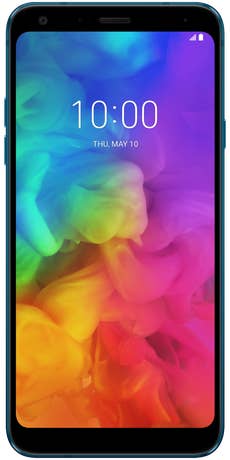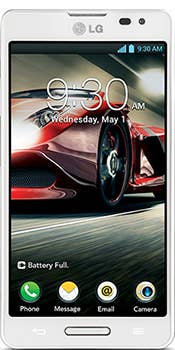LG Q7 vs LG Optimus F7 Vergleich
- Daten
- Preise


Unterschiede hervorheben
Allgemein |
||
| Hersteller | LG | LG |
| Modell | Q7 | Optimus F7 |
| Verfügbar | ✓ | ✗ |
| Marktstart in Deutschland | Juni 2018 | 2. Quartal 2013 |
| Einführungspreis | … | … |
| Onlinepreis |
|
|
| Betriebssystem | ||
| Betriebssystem (OS) | Android Version: 8.1 Oreo | Android Version: 4.1 Jelly Bean |
| Benutzeroberfläche (UI) | Optimus UI | |
Testergebnisse |
||
| Test auf inside digital | Es ist leider kein Testbericht vorhanden | Es ist leider kein Testbericht vorhanden |
Display |
||
| Display Größe | ||
| Pixeldichte | 439 ppi | 312 ppi |
| Auflösung B x H | 1.080 x 2.160 Pixel | 720 x 1.280 Pixel |
| Diagonale Zoll | 5,5 Zoll | 4,7 Zoll |
| Diagonale mm | 139,7 mm | 119,3 mm |
| Typ | IPS | IPS |
| Display-Format | 18:9 | |
Gehäuse |
||
| Gehäusematerial | Aluminium, Kunststoff | Kunststoff |
| Gehäuse-Format | ||
| Höhe x Breite x Tiefe | 143,8 x 69,3 x 8,4 mm | 131,7 x 68,2 x 9,6 mm |
| Schutzart | IP68 | |
| Schutz gegen | Untertauchen | |
| Gewicht | 145 g | … |
| Farben | Schwarz, Blau, Violett | Schwarz Weiß |
Hardware |
||
| Prozessor | ||
| Prozessor / CPU | Mediatek MT6750S | Qualcomm Snapdragon M7225 |
| Arbeitsspeicher (RAM) | 3 GB | 2 GB |
| Akku | ||
| Akku Kapazität | 3.000 mAh | 2.450 mAh |
| Induktives Laden | ✗ | ✗ |
| Speicher | ||
| interner Speicher Größe | 32 GB | 8 GB |
| SD-Kartenslot | ✓ max. 2.000 GB | ✓ max. 32 GB |
| Arten | microSD, microSDXC, microSDHC | microSDHC |
| SIM-Kartenslot | Nano-SIM | Micro-SIM |
| Mehrfach SIM | ✓ Dual-SIM | ✗ |
| Sensoren | Fingerabdrucksensor | Beschleunigungssensor |
| Tasten | ||
| Hardware-Tastatur | ✗ | ✗ |
Konnektivität |
||
| LTE (4G) | ✓ | ✓ |
| 5G | … | … |
| WLAN | ✓ | ✓ |
| Standard |
IEEE 802.11b IEEE 802.11g IEEE 802.11n |
IEEE 802.11a IEEE 802.11b IEEE 802.11g IEEE 802.11n |
| Band | 2.4 GHz | 2.4 GHz |
Anschlüsse & Übertragung |
||
| USB | ||
| USB-Port | ✓ | ✓ |
| Typ | 2.0 Typ C | 2.0 Micro-B |
| Lightning-Connector | ✗ | ✗ |
| Bluetooth | 4.2 | 3.0 |
| Audio-/ Kopfhörerbuchse | 3.5 mm | 3.5 mm |
| NFC | ✓ | ✓ |
| Radio | ✓ | ✗ |
Kamera |
||
| Kameraauflösung | 4160x3120 (13,0 Megapixel) | 3264x2448 (8,0 Megapixel) |
| Sensor | CMOS | |
| Blende | f/2.2 | |
| Bildstabilisator | … | ✗ |
| Digitaler Zoom | ✓ | ✓ |
| Optischer Zoom | ✗ | ✗ |
| Videoauflösung | 1920x1080 (2,1 Megapixel) | 1280x720 (0,9 Megapixel) |
| Aufnahmegeschwindigkeit | 30 fps | fps |
| Blitz / Fotoleuchte | ✓ | ✗ |
| Testbilder |
Es sind leider keine Testbilder vorhanden.
|
Es sind leider keine Testbilder vorhanden.
|
Frontkamera |
||
| Frontkamera | ✓ | ✓ |
| Auflösung | 3264x2448 (8,0 Megapixel) | 1280x1024 (1,3 Megapixel) |
| Videoauflösung | … | 640x480 (0,3 Megapixel) |
Sonstiges |
||
| Besonderheiten |
QLens - KI Kamerafunktion Hi-Fi Qualität Audio DTS:X 3D Surround Sound 2.5D Arc Glass Design Schnelllade-Technologie |
… |
| Lieferumfang |
Handbuch Netzteil |
Handy Akku Ladegerät USB-Kabel Anleitung Speicherkarte |
Was unsere Symbole bedeuten …
- ✓ Ja/Vorhanden
- ✗ Nein/Nicht vorhanden
- … Bislang unbekannt/Wird ergänzt
Wir recherchieren gründlich, um dir die vollständigsten und genauesten technischen Daten zu liefern. Kontaktiere uns, wenn du etwas zu ergänzen hast.

